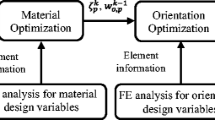Abstract
In conventional reliability-based optimum design of structures, the reliability is computed based on the probability assumption, and the design objective and constraint are considered as deterministic ones. In many cases, however, there exist some fuzzy factors in the design objective and constraint functions. In this paper, the fuzzy reliability and fuzzy constraint are introduced to establish the fuzzy reliability-based optimum model for laminated composites. The examples show that the method developed in this paper can give consideration to both the reliability demand and the economic aspect of a structure. Since the fuzzy reliability-based optimum design is a ‘soft’ design, the present results provide a new methodology for the effective evaluation of structural reliability and bring us an alternative optimum design idea.
Similar content being viewed by others

References
Singha, M.K., Ramachandra, L.S. and Bandyopadhyay, J.N., Optimum design of laminated composite plates for maximum thermal buckling loads. Journal of Composite Materials, 2000, Vol.34: 1982–1997.
Kam, T.Y., Lai, F.M. and Chao, T.M., Optimum design of laminated composite foam-filled sandwich plates subjected to strength constraint. International Journal of Solids and Structures, 1999, Vol.36: 2865–2889.
Riche, R.L. and Haftka, R.T., Optimization of laminate stacking sequence for buckling load maximization by genetic algorithm. AIAA Journal, 1993, Vol.31: 951–956.
Wang, X.Y. and Chen, J.Q., Robust optimum design of laminated composite plates. Acta Mechanica Solida Sinica, 2004, Vol.17, No.4: 315–322.
Ahmed, K.Noor, James, H. and Jeanne, M.Peters, Uncertainty analysis of composite structures. Computer methods in applied mechanics and engineering, 2000, Vol.185: 413–432.
Cha’o-Kuang Chen. A multi-objective fuzzy optimization for optimum dimensions design of a convective spine. Int. Comm. Heat Mass Transfer, 2001, Vol.28, No.1: 67–76.
Lei, W., Tong, L.S. and Yang, H., Fuzzy optimization of an electron optical lens. Nuclear Instruments and Methods in Physics Research A, 1995, Vol.365: 367–370.
Wei, J.H., Chen, J.Q. and Xu, Y.R., Profust reliability of laminated composites. Acta Mechanica Solida Sinica, 2005, Vol.18, No.3: 297–302 (in Chinese).
Chen, J.Q., Wei, J.H. and Xu, Y.R., Fuzzy reliability analysis of laminated composites. Structural Engineering and Mechanics, 2006, Vol.22, No.6: 665–683.
Huang, H.Z., The basic concept and solution idea of fuzzy optimum design. Mechanical Design, 1996, Vol.12: 53–55 (in Chinese).
Guleda Onkal-Engin, Ibrahim dmir and Halil Hiz, Assessment of urban air quality in Istanbul using fuzzy synthetic evaluation. Atmospheric Environment, 2004, No.38: 3809-3815.
Author information
Authors and Affiliations
Additional information
Project supported by the National Natural Sciences Foundation of China (No.10272049).
Rights and permissions
About this article
Cite this article
Wei, J., Chen, J. & Ge, R. Fuzzy reliability-based optimum design of laminated composites. Acta Mech. Solida Sin. 19, 255–263 (2006). https://doi.org/10.1007/s10338-006-0631-7
Received:
Revised:
Published:
Issue Date:
DOI: https://doi.org/10.1007/s10338-006-0631-7



